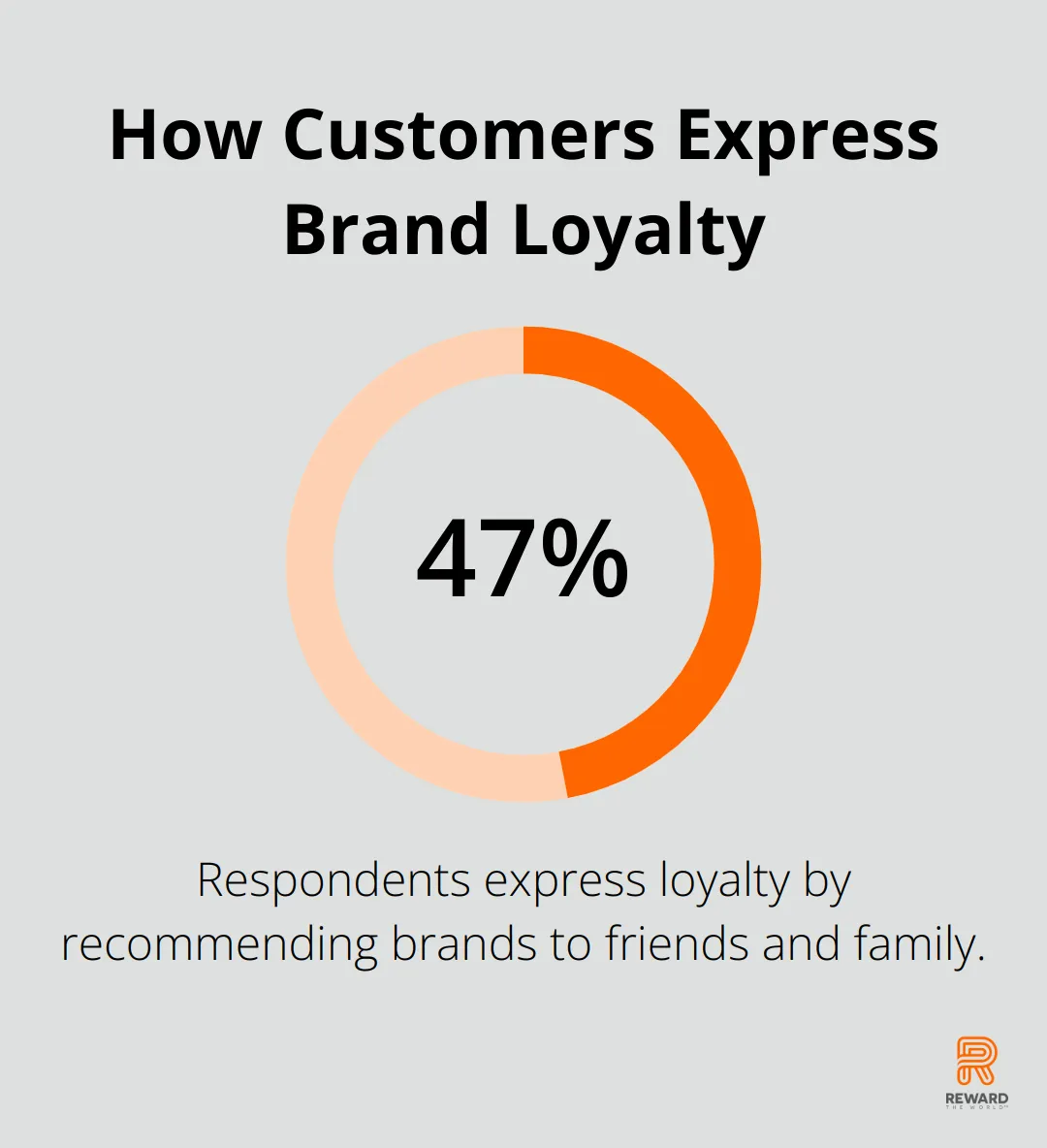
Social proof is a powerful tool that can transform your loyalty program from good to great. At Reward the World, we’ve seen firsthand how leveraging social proof can significantly boost engagement and retention rates.
In this post, we’ll explore effective strategies to incorporate social proof into your loyalty program and measure its impact. Get ready to unlock the full potential of your customer loyalty initiatives.
What Makes Social Proof Tick in Loyalty Programs?
Social proof is a psychological phenomenon where people tend to imitate the actions of others or look at others while making decisions. In loyalty programs, it’s a powerful force that can transform engagement and retention rates.
The Power of Numbers
Social proof in loyalty programs often boils down to statistics. When customers see thousands of others participating and reaping benefits, they’re more likely to join and remain active. A Nielsen study revealed that consumers were 77% more likely to buy a product if their friends recommended it. This trust extends to fellow loyalty program members, creating a ripple effect of participation.

User-Generated Content: The Ultimate Social Proof
User-generated content (UGC) stands as the pinnacle of social proof for loyalty programs. It’s authentic, relatable, and incredibly persuasive. For instance, the Starbucks White Cup Contest generated over 40,000 social media mentions. This type of engagement not only promotes the brand but also showcases the active participation of loyalty program members (a win-win situation for both the company and its customers).
The Psychology of FOMO
Fear of Missing Out (FOMO) acts as a powerful driver in loyalty programs. When customers see others earning rewards and enjoying exclusive experiences, it motivates them to participate more actively. This underscores the effectiveness of showcasing member benefits (and the potential loss for non-participants).
Creating a Community of Loyal Customers
Social proof in loyalty programs extends beyond mere numbers. It creates a community where members feel valued and connected. This sense of belonging fosters long-term engagement and brand loyalty. Successful programs (like those offered by Reward the World) leverage these psychological principles to create a thriving ecosystem of loyal customers.
The Role of Influencers and Brand Ambassadors
Influencers and brand ambassadors play a significant role in amplifying social proof. Their endorsements and experiences with loyalty programs can sway their followers’ opinions and actions. This form of social proof taps into the trust and credibility these influencers have built with their audience, making it a powerful tool for loyalty program promotion.
As we move forward, let’s explore effective strategies to incorporate these social proof elements into your loyalty program and maximize their impact.
How to Supercharge Your Loyalty Program with Social Proof
Unleash the Power of User-Generated Content
User-generated content (UGC) transforms loyalty programs. We encourage loyalty program members to share experiences, reviews, and photos. UGC has the potential to markedly enhance brand trust and purchase intention. Brands that proactively engage in UGC are more likely to see positive results. To replicate successful UGC campaigns:
- Create a branded hashtag for your loyalty program
- Offer bonus points for high-quality UGC submissions
- Feature the best content on your website and social media channels
(Always obtain permission before using customer content.) This approach provides social proof and makes members feel valued.
Leverage Social Media for Maximum Impact
Social media amplifies social proof. According to a recent study, 47% of respondents express their loyalty by recommending brands to friends and family. Here’s how to leverage this:

- Integrate social sharing buttons into your loyalty program platform
- Reward members for sharing achievements on social media
- Create exclusive content for loyalty program members to share
You could offer a “double points day” for members who share purchases on Instagram. This strategy increases visibility and attracts new members through peer recommendations.
Gamify Your Loyalty Program
Gamification adds fun and competition to your loyalty program, naturally generating social proof. Try these tactics:
- Implement a points leaderboard
- Create achievement badges for different milestones
- Organize time-limited challenges with exclusive rewards
Nike’s Run Club app uses gamification to keep users engaged, with challenges and achievements that members can share on social media. This motivates existing members and attracts new ones through social proof.
Partner with Influencers and Brand Ambassadors
Influencer partnerships boost your loyalty program’s credibility. According to a Tomoson influencer marketing study, businesses see an average rate of return of $6.50 for every $1 spent on influencer marketing. To leverage this:
- Identify influencers who align with your brand values
- Offer them exclusive experiences through your loyalty program
- Encourage them to share experiences with their followers
Sephora’s Beauty Insider program partners with beauty influencers to showcase the benefits of their tiered loyalty system. This strategy provides social proof and reaches a wider audience.
Measure and Optimize Your Social Proof Strategies
To truly harness the power of social proof, you need to measure its impact. (This is where platforms like Reward the World shine, offering robust analytics to track your loyalty program’s performance.) In the next section, we’ll explore how to effectively measure the impact of social proof on your loyalty program and use these insights to optimize your strategies.
How to Measure Social Proof’s Impact on Your Loyalty Program
At Reward the World, we understand the importance of measuring social proof’s impact on loyalty programs. This chapter explores key metrics, tools, and real-world examples to help you assess the effectiveness of your social proof initiatives.
Track Engagement Metrics
One of the most direct ways to measure social proof’s impact is through engagement metrics. These include:
- Referral rates: Count how many new members join your program through existing member referrals.
- Social shares: Monitor the number of times your loyalty program content appears on social media platforms.
- User-generated content (UGC) submissions: Keep tabs on the quantity and quality of UGC your program receives.

Analyze Conversion and Retention Rates
Social proof can significantly impact both conversion and retention rates. Keep an eye on:
- Program enrollment rate: Monitor how quickly new customers sign up for your loyalty program.
- Active member ratio: Track the percentage of members who regularly engage with your program.
- Churn rate: Measure the rate at which members leave your program.
A study analyzed the impact of loyalty card programs on customer behavior in the Albanian market.
Leverage Advanced Analytics Tools
To truly understand the impact of social proof, you need robust analytics tools. These tools can help you:
- Segment your audience based on engagement levels
- Identify which social proof elements are most effective
- Conduct A/B tests to optimize your strategies
A/B testing tools can be valuable for optimizing your loyalty program strategies.
Implement Customer Feedback Loops
Create mechanisms to gather direct feedback from your loyalty program members about the social proof elements. This can include:
- Surveys: Ask members about their experiences with social features
- Focus groups: Conduct in-depth discussions with select members
- Social media listening: Monitor conversations about your program online
This qualitative data complements your quantitative metrics and provides valuable insights into member perceptions and preferences.
Set Benchmarks and Goals
Establish clear benchmarks and goals for your social proof initiatives. This allows you to:
- Compare your performance against industry standards
- Set realistic targets for improvement
- Motivate your team to achieve specific objectives
Try to review these benchmarks regularly and adjust them based on your program’s performance and evolving market trends.
Final Thoughts
Social proof has revolutionized loyalty programs, tapping into human psychology and the desire to belong. Businesses now create thriving communities of engaged customers through user-generated content, gamification, and influencer partnerships. These strategies work together to amplify the impact of loyalty initiatives and foster genuine connections with customers.
The future of social proof in loyalty marketing looks promising, with artificial intelligence and machine learning enabling more personalized experiences. Virtual and augmented reality technologies may soon allow customers to experience loyalty program benefits before joining, potentially increasing adoption and engagement rates. However, brands must balance leveraging social proof with maintaining authenticity to preserve trust and credibility.
We at Reward the World offer a comprehensive solution for businesses looking to harness the full potential of social proof in their loyalty programs. Our global reach and instant reward delivery can help you create a loyalty program that effectively leverages social proof and drives real business results. With our robust analytics, you can measure the impact of your social proof strategies and optimize your program for maximum engagement.
